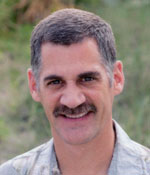
On what would be my longest flight at that point in my Air Force career—flying an F-15C Eagle 3,800 miles from Brisbane, Australia, to Okinawa, Japan—I worried that I’d have to make an embarrassing radio call to my flight lead. It was to be an eight-hour flight with six aerial refuelings, and for the moment I was doing some of the flying with my knees. I was trying to free my right hand, which had gotten stuck beside my seat trying to reach a gallon jug of water that had slid from its holding place.
 I was a young, eager first lieutenant flying formation with a KC-135 tanker, another F-15, and six Royal Australian Air Force F-111s on a ferry flight after an airshow in Australia. To avoid dehydration, I had bought a gallon jug of water to supplement the water flask I carried in my G suit. I put the water on the right side panel behind the map case, but I thought that if it leaked I might get some avionics components wet; so I moved it to the floor under my ejection seat just behind my right foot.
I was a young, eager first lieutenant flying formation with a KC-135 tanker, another F-15, and six Royal Australian Air Force F-111s on a ferry flight after an airshow in Australia. To avoid dehydration, I had bought a gallon jug of water to supplement the water flask I carried in my G suit. I put the water on the right side panel behind the map case, but I thought that if it leaked I might get some avionics components wet; so I moved it to the floor under my ejection seat just behind my right foot.
The floor of the F-15 is bare aluminum. On takeoff, when the jet accelerated and pitched up, the jug slid backward to the bulkhead just behind my seat. Reminding myself to fly the airplane first, I calmly continued the takeoff and joinup with the tanker and planned to get my water later.
Still climbing in loose formation, I grabbed the center-mounted stick with my left hand and shoved my right hand down the side of my seat into the small gap. I slid the jug to the front with my fingers. My left hand could grab the jug, but my right hand was stuck. I had to fly formation with my left hand alternating between the throttles and stick. And no matter how hard I pulled I couldn’t free my right hand. Would I have to call my flight lead to tell him that I had to turn back and land because my hand was stuck? Could I fly all the way to Okinawa this way? It would be impossible to refuel one handed. Landing would be easier. I figured I’d try extricating my hand some more before I made the radio call of shame.
Once we leveled off, I used the autopilot’s altitude mode (there was no heading mode), which allowed me to wiggle the seat slowly up and down with my left hand, wiggle my right hand, and work the stick with my knees. After 20 minutes, my hand was free.
What if I never could get my hand out? Did I have a plan? I knew my fuel status and range. I knew where our alternates were as we flew up the Australian coast. I knew that the weather was VFR at those airfields. My plan was to land from a straight-in approach. From a stabilized approach I could get configured, set my power to hold approach airspeed, and trim the jet to hold my glidepath. Once over the numbers, my left hand could easily move the throttles to idle and then move to the stick to flare for landing. I’m confident I could have landed safely. The key, no matter what aircraft you are flying, is always to fly the airplane first.
Larry Brown of Colorado Springs, Colo., is a retired Air Force F-15 pilot who is using the lessons he learned as a fighter pilot as a GA pilot in his Cessna P210. Brown, who has 2,600 hours total time during his 32 years of flying, also was an instructor pilot and flight examiner in the Air Force T-38 and instructor pilot in the T-52, the military’s version of GA’s Diamond DA40.



